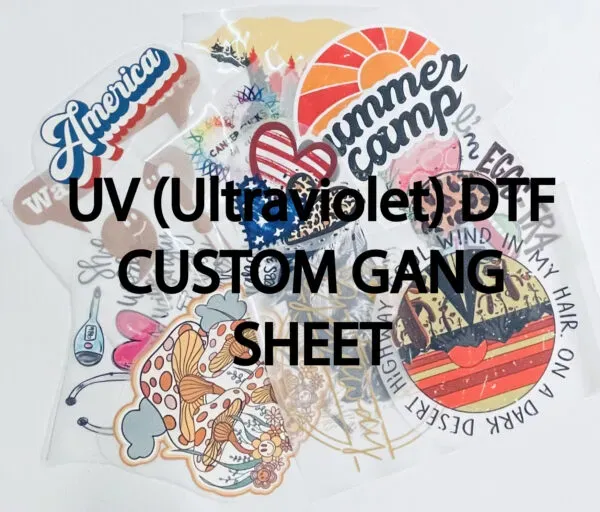In the rapidly evolving textile industry, UV DTF Gangheet stands out as a groundbreaking innovation that is reshaping how fabrics are printed and customized. This advanced printing technique combines UV printing technology with Direct to Film (DTF) processes, allowing for vibrant designs and high-quality results without the lengthy drying times associated with traditional methods. As sustainability rises as a cornerstone of consumer demand, UV DTF Gangheet contributes significantly to sustainable printing practices, minimizing waste and using less harmful inks. Moreover, the versatility of this approach enables businesses to cater to a diverse range of textile applications, from apparel to home décor. Join us as we explore the myriad benefits and transformative potential of UV DTF Gangheet within the textile landscape.
The textile sector is witnessing an exciting shift with the introduction of innovative printing methodologies, commonly referred to as direct printing techniques, including the UV DTF process. This particular approach not only streamlines the printing journey but also enhances print quality while adhering to eco-friendly principles. With the integration of ultraviolet technology in DTF printing, manufacturers are better equipped to meet diverse custom textile printing needs efficiently. Emphasizing sustainability and reduced environmental impact, these modern printing solutions facilitate unique and personalized designs that resonate with today’s conscious consumers. As we delve deeper, we will uncover the advantages of this advanced printing solution and its significance in shaping the future of the fabric industry.
Understanding UV DTF Gangheet
UV DTF Gangheet represents a significant leap forward in textile printing technology, merging the precision of direct-to-film processes with the rapid curing benefits of UV inks. This innovative method allows for vivid designs on fabrics of various types, including cotton, polyester, and blend materials. Unlike traditional printing techniques that may require hours to dry, UV DTF printing can cure designs almost instantly, allowing businesses to enhance productivity while maintaining high-quality outputs.
The technology behind UV DTF Gangheet also allows for better adhesion and durability of prints, resulting in vibrant colors and intricate patterns that withstand regular washing and wear. This robustness is crucial for manufacturers seeking to provide quality products in a competitive market. Furthermore, UV DTF technology is adaptable, making it ideal for custom textile printing, helping businesses meet the growing consumer demand for personalized products.
Frequently Asked Questions
What is the UV DTF Gangheet and how does it benefit the textile industry?
The UV DTF Gangheet is a revolutionary printing technology in the textile industry that utilizes UV inks for Direct to Film (DTF) printing. It benefits the industry by providing enhanced print quality, faster production times, and versatility on various substrates, leading to efficient customization and sustainability in textile manufacturing.
How does UV DTF printing differ from traditional DTF printing methods?
Unlike traditional DTF printing, which employs solvent inks requiring lengthy drying times, UV DTF printing uses UV-curable inks that cure instantly when exposed to UV light. This advancement allows for quicker production cycles and improved print durability, making it an attractive option for the textile industry.
What are the environmental advantages of using UV DTF Gangheet in textile printing?
UV DTF Gangheet offers several environmental advantages, including the use of less harmful inks, reduced ink waste due to precise printing, and the promotion of sustainable practices among companies. These factors contribute to a lower environmental impact and a growing demand for eco-friendly textile solutions.
Can UV DTF printing be applied to different fabrics, and what materials work best?
Yes, UV DTF printing can be applied to a wide range of fabrics, including cotton, polyester, and synthetic materials. This versatility enables businesses in the textile industry to create diverse products, from clothing to home decor, thus catering to varied consumer preferences.
What role does customization play in the success of UV DTF Gangheet?
Customization is a key driver of success for UV DTF Gangheet, as consumers increasingly demand personalized products. UV DTF technology allows for rapid customization without compromising on quality, which is critical in today’s fast-paced textile market, particularly in fashion and promotional products.
What future trends can we expect with UV DTF printing in the textile industry?
Future trends in UV DTF printing may include advancements in high-speed printers, innovative ink formulations, and enhanced software solutions for design and color management. As market demand for customizable and sustainable textile products grows, these innovations will likely lead to increased efficiency and quality in the industry.
| Feature | Description |
|---|---|
| What is UV DTF Printing? | A method applying designs onto a film, transferred to fabric using heat and pressure with UV-curable inks that cure instantly, enhancing productivity. |
| Enhanced Print Quality | UV inks provide vibrant colors, intricate designs, and a glossy finish that withstands washing and fading. |
| Versatility | Can be used on various substrates like cotton, polyester, allowing for diverse products from apparel to decor. |
| Faster Production | Rapid curing allows for quicker multiple layer printing, crucial for meeting tight deadlines. |
| Cost-Effective | Shorter production times lead to reduced costs, advantageous for small to medium enterprises. |
| Environmental Benefits | Less toxic inks, reduced waste, and adoption of sustainable practices cater to eco-conscious consumers. |
| Market Growth and Demand | Projected growth fueled by trends in customization, quick turnarounds, and increased investment in UV DTF technology. |
Summary
UV DTF Gangheet is profoundly transforming the textile industry by enhancing the quality and efficiency of fabric printing. This innovative technology, utilizing UV-curable inks, not only ensures vibrant and durable prints, but also supports sustainable practices through reduced ink waste and less harmful chemicals. As the demand for customized textile products grows, businesses that harness UV DTF Gangheet will likely lead the market, meeting consumer expectations for quality and sustainability. The ongoing advancements and investments in this technology pave the way for a more dynamic future in textile printing, aligning production with ecological responsibilities.




